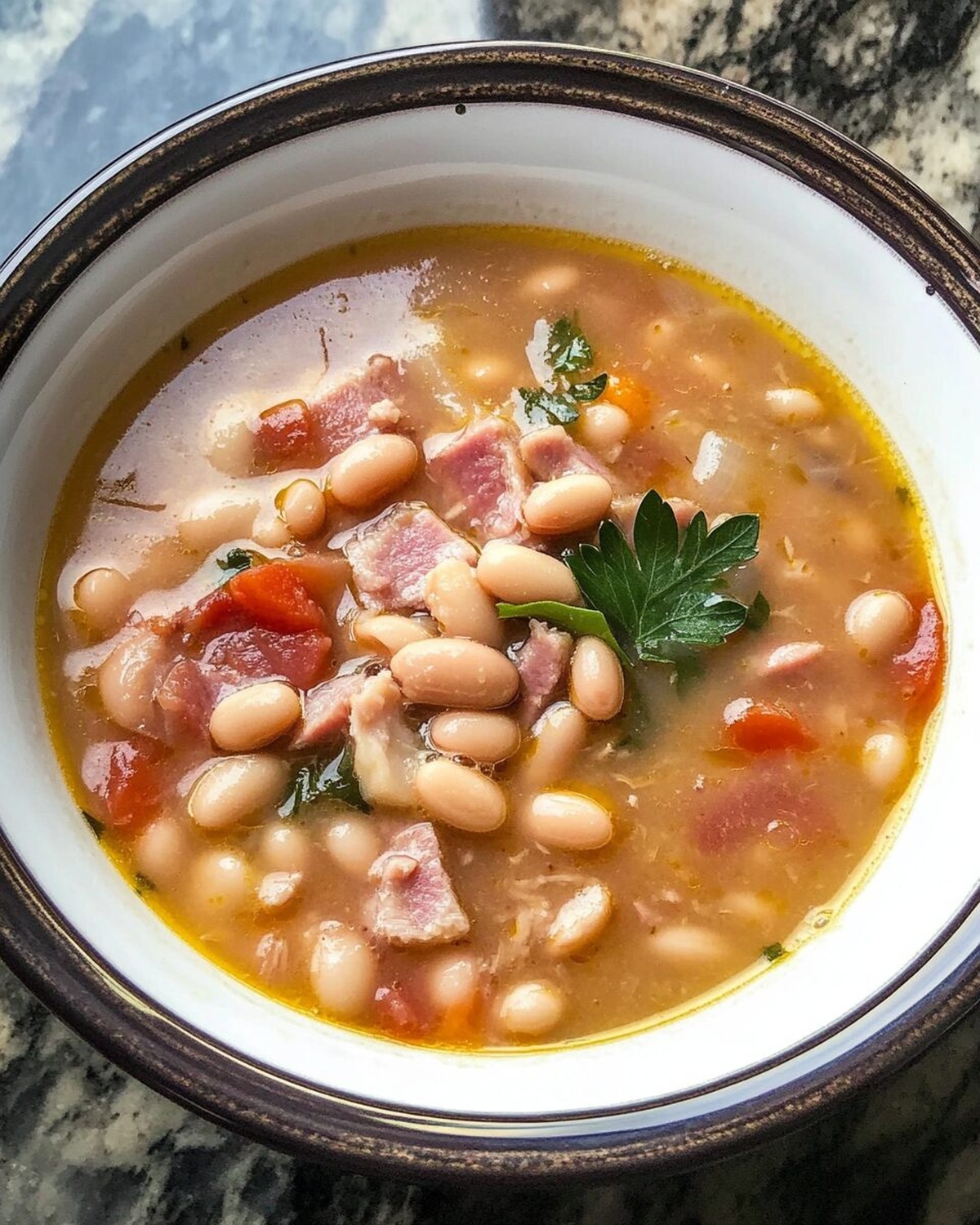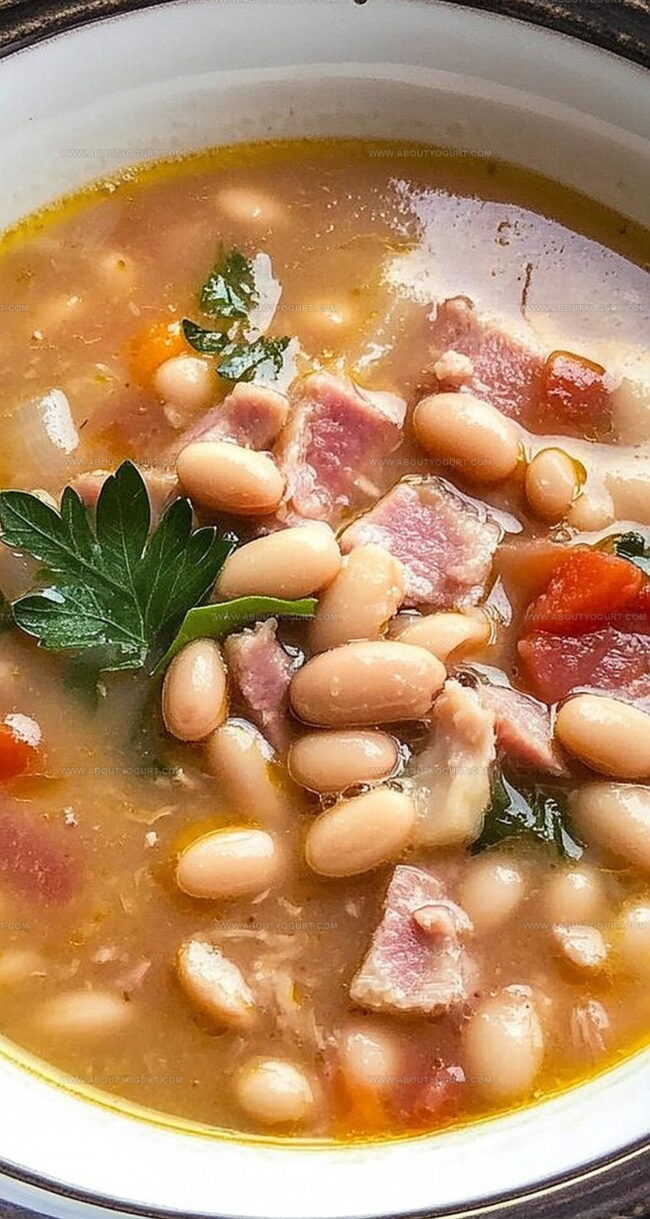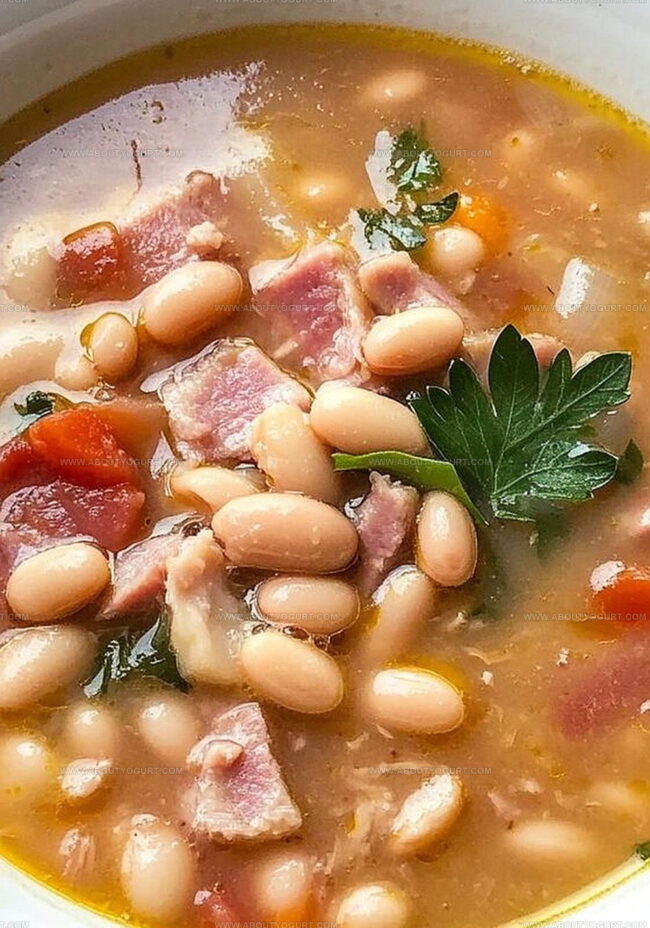Cozy White Bean and Ham Soup Recipe for Chilly Evenings
Comfort arrives with this hearty white bean and ham soup that whispers stories of home-cooked warmth.
Grandmothers across kitchens have perfected such rustic recipes through generations of loving preparation.
Tender beans nestle alongside smoky ham chunks, creating a symphony of satisfying flavors.
Rich broth promises deep nourishment with every spoonful of this classic dish.
Mediterranean and southern American culinary traditions merge beautifully in this simple yet elegant soup.
Herbs like thyme and parsley dance through the liquid, adding subtle complexity to each bite.
You’ll want to ladle this soul-warming soup into deep bowls and savor every comforting spoonful.
Why White Bean and Ham Soup Deserves a Spot at Your Table
Ingredients to Make White Bean and Ham Soup Shine
Protein Base:Aromatic Vegetables:Herbs and Seasonings:Cooking Liquid:How to Prepare White Bean and Ham Soup Step by Step
Step 1: Prepare Dried Beans
Rinse the dried beans thoroughly. Place them in a large pot filled with water.
Bring to a rolling boil, then remove from heat. Cover the pot and let the beans soak for two hours.
Drain and set aside for later use.
Step 2: Cook Ham Base
Place ham shanks or hocks in a large pot.
Pour water to cover the meat. Sprinkle Herbes de Provence over the top.
Bring the liquid to a gentle simmer on high heat, then reduce to low. Cook partially covered for one hour, allowing the flavors to develop.
Step 3: Sauté Aromatic Vegetables
Heat olive oil in a skillet over medium-high heat. Add:Cook onions until they become translucent and slightly golden.
Add minced garlic and sauté for an additional minute to release its fragrant oils.
Step 4: Combine Ingredients
Transfer the sautéed vegetables into the ham pot.
Add:Stir to combine all ingredients evenly.
Step 5: Simmer and Shred
Continue cooking uncovered for approximately 40 minutes.
The vegetables should become tender and the ham meat should easily pull away from the bone. Remove the bones carefully.
Shred the ham meat and return it to the soup pot.
Step 6: Season and Finish
Season the soup with:Stir in freshly chopped parsley just before serving.
Taste and adjust seasonings as needed.
Tips to Elevate White Bean and Ham Soup
Easy Adjustments for White Bean and Ham Soup
What to Pair with White Bean and Ham Soup
Storage Guide for White Bean and Ham Soup
FAQs for White Bean and Ham Soup Lovers
The beans are ready when they’ve doubled in size and look plump and soft after 2 hours of soaking.
Yes, you can substitute dried parsley, but use about 1/3 the amount of fresh parsley since dried herbs are more concentrated.
Great Northern beans and cannellini beans are excellent choices that hold their shape well and provide a creamy texture.
Yes, removing the bones makes the soup easier to eat and allows you to shred the ham meat directly into the soup for better distribution of flavor.
Print
Warming White Bean and Ham Soup Recipe
- Total Time: 3 hours 46 minutes
- Yield: 6 1x
Description
Hearty white bean and ham soup brings comfort from Southern kitchens, blending rustic ingredients with rich culinary traditions. Savory ham, tender beans, and aromatic herbs create a satisfying meal you’ll crave on chilly evenings.
Ingredients
Main Protein:
- 2 to 3 pounds smoked ham shanks or ham hocks
- 1 pound (2 1/2 cups) dried white beans (Cannellini or Great Northern)
Vegetables:
- 1 small onion, diced (about 1 cup)
- 2 to 3 ribs celery, chopped (about 1 cup)
- 1 medium carrot, chopped (about 2/3 cup)
- 2 to 3 cloves garlic, minced
Seasonings and Liquids:
- 2 quarts water
- 1 tablespoon extra virgin olive oil
- 2 teaspoons Herbes de Provence or Italian seasoning
- Tabasco sauce, to taste
- Salt, to taste
- Freshly ground black pepper, to taste
- Fresh parsley, chopped for garnish
Instructions
- Hydrate dried white beans by submerging in boiling water, then letting them soak for 2 hours. Drain thoroughly and reserve.
- Place ham shanks in a large pot, covering with water and Herbes de Provence. Gently simmer on low heat for 1 hour, partially covered.
- While ham cooks, caramelize onions in olive oil over medium-high heat until translucent, approximately 5 minutes. Quickly incorporate minced garlic and cook for an additional minute.
- Combine soaked beans, sautéed aromatics, chopped celery, and carrots into the ham broth. Maintain a gentle simmer.
- Continue cooking uncovered for 40 minutes, allowing vegetables to soften and ham to become tender enough to separate from bone. Extract bones, shred meat, and reintegrate into soup.
- Season with Tabasco sauce, salt, and pepper according to preference. Garnish with freshly chopped parsley just before serving, enhancing the soup’s aromatic profile.
Notes
- Soak beans thoroughly to reduce cooking time and improve digestibility, ensuring they’re soft and easy to break down.
- Choose high-quality ham shanks with good marbling for richer, more intense flavor that permeates the entire soup.
- Consider using smoked ham hocks for deeper, smokier undertones that elevate the soup’s overall taste profile.
- Customize for dietary needs by substituting ham with smoked turkey or vegetable broth for a lighter, meat-free version that maintains robust flavor complexity.
- Prep Time: 2 hours
- Cook Time: 1 hour 46 minutes
- Category: Lunch, Dinner, Appetizer
- Method: Simmering
- Cuisine: American
Nutrition
- Serving Size: 6
- Calories: 350
- Sugar: 2 g
- Sodium: 800 mg
- Fat: 10 g
- Saturated Fat: 2 g
- Unsaturated Fat: 7 g
- Trans Fat: 0 g
- Carbohydrates: 45 g
- Fiber: 12 g
- Protein: 25 g
- Cholesterol: 50 mg




Michael Thompson
Founder & Recipe Developer
Expertise
Education
Cascade Culinary Institute – Bend, OR
ServSafe Food Handler Certification – Portland, OR
Focus: Certified in core food safety and hygiene principles for both home and professional kitchens, with emphasis on ingredient handling, kitchen cleanliness, and safe preparation methods.
Mike’s kitchen journey began with a single goal: to make everyday meals feel like something worth celebrating.
After earning his Certificate in Culinary Arts from Cascade Culinary Institute, he spent years working with local farmers and small kitchens across Oregon, learning the beauty of seasonal, small-batch cooking.
Mike’s approach is simple, cook with what’s fresh, keep it approachable, and always leave room for a little creativity. When he’s not testing yogurt marinades or designing single-serving meals, you’ll find him hiking trails or hunting down the best berries at local markets.